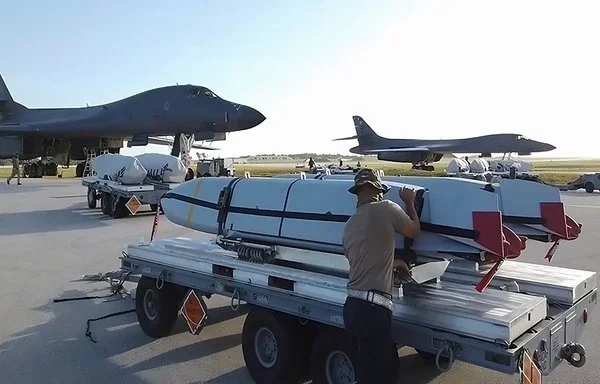The United States' Bomber Task Force (BTF) has established itself as a highly accurate and lethal component of global military operations, particularly when combined with Joint Air-to-Surface Standoff Missiles (JASSMs).
BTF missions, which began in 2018, involve the regular and routine deployment of US bomber forces worldwide to develop the ability to operate from unfamiliar locations and integrate with allies and partner nations.
US bomber deployments used to need to be planned far ahead of time.
The BTF model now allows strategic bombers to fly on a moment's notice, and has seen US bombers landing for the first time in places without a permanent US bomber presence, including Romania and Iceland.
These operations enhance regional training opportunities, improve integration with allied forces and ensure operational readiness to respond to emerging threats.
The BTF deployment model has evolved over the years as a means to deploy a tailor-built task force of bombers in a Geographic Combatant Command to serve each commander's unique priorities.
Bomber fleet
The BTF fleet includes roughly 140 active long-range bombers, including B-52H Stratofortresses, B-2 Spirit aircraft and B-1B Lancers.
The B-1B, a supersonic variable-sweep wing heavy bomber, can carry up to 34,000kg of ordnance -- the largest conventional payload of guided and unguided weapons in the US Air Force inventory.
It is equipped with variable-geometry wings and turbofan engines that provide long range, high speed and enhanced survivability, as well as an advanced radar targeting system and electronic countermeasures.
Low-observable technology distinguishes the B-2 Spirit, enabling it to penetrate deep into enemy territory to deliver both conventional and nuclear munitions.
Its signature flying-wing design provides high aerodynamic efficiency and a large payload capacity, allowing it to carry out long-range, high-altitude missions with significant firepower.
The B-52 Stratofortress is capable of performing a variety of missions, including strategic attack, close-air support, air interdiction and maritime operations.
It can carry the widest array of weapons in the US inventory, including nuclear and precision-guided conventional ordnance.
And it comes with advanced targeting pods and night vision capabilities that enhance its combat effectiveness in all weather conditions and during night operations.
Long-range strike
All three types of bombers can carry the JASSM, a long-range air-launched cruise missile designed to strike high-value, heavily defended targets from distances of up to 370km.
A state-of-the-art infrared seeker, low-observable airframe and Global Positioning System-assisted interior navigation enhance its stealth and precision, allowing it to penetrate dense air defense networks and strike high-value targets with high accuracy.
The low-observable airframe is designed to evade sophisticated enemy air defenses, including systems like the S-300 and its newer variants.
The missile can store three-dimensional targeting models of up to eight intended targets, and is capable of achieving a Circular Error Probable (CEP) of within 3 meters.
It weighs more than 1,000kg and contains a 432kg penetrator and blast fragmentation warhead, making it effective against hardened structures and critical enemy infrastructure.
The AGM-158 JASSM saw its first combat use in April 2018 during strikes against Syria's Barzah Research Development Center. The United States deployed 19 JASSM-A missiles to destroy the facility, which manufactured chemical weapons.
The United States also used multiple JASSM-ER missiles in October 2019 in the military operation against "Islamic State of Iraq and Syria" (ISIS) leader Abu Bakr al-Baghdadi in Syria.
An extended range variant, JASSM-ER, significantly enhances the missile's reach, pushing its range up to 1000km.
The JASSM-ER will eventually be upgraded with a weapons data link (WDL), enabling course corrections after launch, a vital feature for engaging road-mobile and maritime targets.







Strike the Houthis and spare none!
ReplyMay Allah protect our Arab world and grant Palestine a resounding victory!
Reply